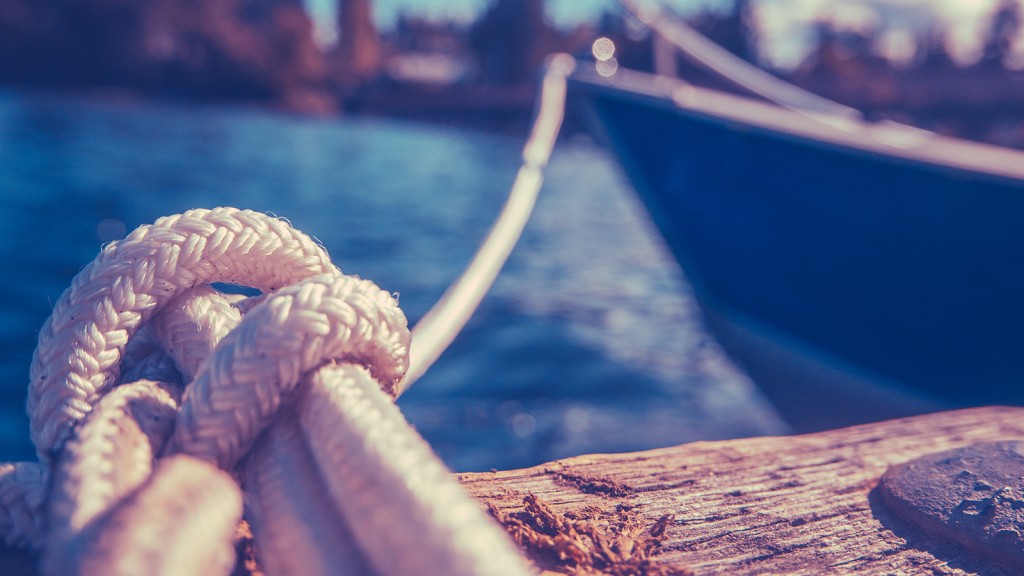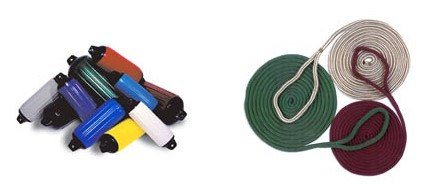Mooring, Docking, and Berthing
The more you sail the better you become at it and this also applies to the knowledge you manage to acquire in the field. Expert sailors have a language of their own and it takes quite a long time to master it.
The difference between Mooring, Berthing and Docking
Nonetheless, there are a few basic terms any novice should get acquainted with. Three of them are the object of this post. Read on and discover the difference between mooring, docking, and berthing.
Mooring
Mooring is one of the buzzwords you will have to get used to if you want to become a sailor. The process of mooring a vessel implies securing it to a fixed-point with the help of ropes or lines. By mooring, you basically make sure your boat is secured on a single point which, in its turn, is attached to the seafloor. This single point is called a marina mooring and it consists of an anchor, a float and a rode. By getting a mooring reservation, your boat will practically be anchored on the water.
Also, it’s useful to remember that there is a particular type of mooring which is known as the Mediterranean mooring. This implies that the boat is secured to the anchor in a manner that resembles the berthing technique. With this method your boat’s stern will be oriented towards a dock. The boat basically moves in reverse until it reaches the dock. Although it resembles a berthing maneuver, the point which keeps the vessel secured is not the dock, but an anchor, therefore, it is a mooring technique. As its name suggests, this technique is popular in Mediterranean marinas, more precisely those located in Europe where, due to lack of space, many boats need to be anchored to the same pier, occupying the space allocated to their width.
Docking and Berthing
Docking and mooring are often confused as they coincide up to a certain point. By docking your boat, you practically sail until you reach a fixed structure that allows you to get out on the land. This structure is called a dock and your boat is fastened to it.
Berthing means placing your vessel in the fixed location known as a berth. To make it easier to understand, imagine that the berth is basically your boat’s parking place. Berthing refers to the whole process of maneuvering your boat until it is secured in the fixed position in its berth. Therefore, we can say that berthing your boat means parking it in a designated area.
A mooring reservation is different from a marina reservation as the latter enables you to disembark directly, while the first doesn’t grant access to the shore.
Docking and Mooring Equipment
Both docking and mooring require typical equipment, let’s see what you need for each one of them so that you know what you should bring aboard on every occasion.
Marina moorings require you to have the following 3 essential components:
- anchor – it uses its heavy weight to keep the boat in a fixed position on the seafloor
- mooring chain – it connects the anchor to the floating buoy
- mooring buoy – the floating device connected to the anchor used to mark the place where the boat is moored
Docking also makes it necessary to equip your boat with the minimum gear which consists of
- fenders: these devices vary in size depending on each boat which they protect by acting as a buffer between the boat and the dock or other surrounding vessels
- lines: these are the ropes that help you fasten your boat to the shore
Other pieces of equipment such as dock steps, whips, hooks or other accessories are also a good addition aboard, especially if your boat spends a lot of time tied to the shore.
Berthing, Mooring and Picking up a Buoy – How to
Berthing, mooring and picking up a buoy are some of the most common notions you should get familiarized with if your passion is sailing. In this post, we are going to provide you with some basic information about each one of them. Read on and learn more.
1. How to Berth
Berthing refers to the process of mooring the boat in the designated places called boat berths. In simple words, when you’re berthing your boat, you’re ‘parking’ it in the allocated berth. There are few steps to take into account before and while berthing.
Firstly, no matter where you book berths, it’s always recommended to call before you arrive at the harbor. The marina’s staff will tell you exactly where your berthing place is, so that you will know where to head to and whether you should enter the port by coming in bow or stern.
Then, before you enter the port, you should get ready to berth by putting the fenders out of the boat and preparing your lines. You should have minimum four lines: for the stern, the bow and the two midship lines.
As you approach your boat berth, you should slow down so that you can fit the vessel into the designated space and then stop it so that you can moor it.
2. How to Moor
Boat mooring means tying a boat so that it is secured in a determined place. The art of mooring is one of the basic skills you will learn as a sailor. There are different ways of mooring as you can moor your boat by using a buoy, a dock or the sea bottom.
There are several items you need in order to moor:
- the bow line and the stern line, which will prevent the vessel from moving from right to left by connecting the bow cleat and the stern to the dock
- the fenders which will avoid any damage to your hull as they act as a cushion against the dock
- the cleat, which is the support you use in order to secure the boat’s lines
There are different types of knots that you can use to tie your boat to the moorings. Some of the most common ones are the following:
- the round turn and two half hitches: one of the most common mooring knots that can also be easily unfastened. This knot is performed in two steps; the first one (the round turn) means you pass the rope twice around the mooring ring or the dock post. The second step or the half hitch implies making a figure eight knot with your line around the cleat.
- the clove hitch: it provides a safe mooring because it relies on a very strong hold. The clove hitch is formed by two reversed half hitches. This is the best type of knot you can use if you want to secure your boat to a pole.
- mooring hooks are another mooring solution that can help you secure your boat fast. If you choose this method, make sure your lines are tight so that the water movement doesn’t loosen them.
One of the easiest ways of mooring is picking a place between the pontoon and another boat. If you have access to such moorings, you can use the other boat as a support to get to your pontoon, then throw the lines and fasten them to the cleats.
There are different ways of mooring your boat; you can use the midship line or the stern line if you approach the pontoon stern first.
The typical mooring method used for larger boats is by using a spring line that will prevent the vessel from moving forward or backward. These lines are longer than the lines of the bow and the stern and actually exceed the length of the vessel. Spring lines connect the dock cleat and the bow cleat with the stern cleat.
3. How to pick up a mooring buoy
Boat buoys are the floating objects used in ports to direct the vessels and indicate any possible dangers. Picking up a buoy can be a tedious duty, but with sufficient practice, you’ll tackle this issue. When you’re looking for a buoy, you have to understand how it is positioned. This way, you can avoid causing unpleasant damage to the boat’s rudder or the propeller.
When you approach the buoys, from the helm, you should consider the force of the wind and the tides and go against which one is strongest. Ideally, the buoy will be located off the starboard bow.
When you prepare to pick the buoy up, try to do it from one side and not ahead, to ease your work. You can use a hook to grab the buoy by passing a line around it and dragging it to the boat. If the buoy has no pick-up line, these hooks are ideal for creating a connection between the buoy’s ring or hoop and your boat. In some cases, both the pick-up line and the hook might be missing so, you have to drag the buoy by using a line to form a lasso. The line chosen for this task has to be one that will sink not float. If you grab the buoy by this means, it should only remain in the lasso before you properly moor. Therefore, you should remove the lasso and properly secure the buoy with a line. The ends of the line have to be secured to the bow cleats. And if you are planning a longer stay, you should take an extra step for safety and use an additional line with full turn. This way, you can also prevent boat scratches.
Alternatively, you can pick up buoys by approaching them astern, which will help you fasten the lines far easier. However, you should pay attention as it’s easy to damage the propeller if you are not careful.
Berthing, mooring and picking up a buoy are just a few of the basics you have to learn if you want to build a passion for sailing. We can help you with plenty other useful sailing tips and recommendations, so check out the rest of our articles.
Berths in the Mediterranean
Berths in the Mediterranean can be found in different top tourist destinations in Europe. The South of the old continent is one of the most appreciated cruising areas in the world. The best regions to sail to in Europe are located in Italy, France, Spain, Croatia, and Montenegro. Discover the most beautiful areas in these countries where you can book marina berths.
- Italy. The most elegant and well-provided slips in Italy are located in: Sardinia, Sicily, Campania, Calabria, Puglia, Tuscany, Latium, Liguria, Veneto, Emilia Romagna.
- France. The South of France is famous worldwide for its stunning Côte d’Azur. If you are looking for slips in France in the area, try Saint Tropez, Antibes, Cannes, Nice. Another must-see is the island Corsica.
- Spain. Moorings for rent in Spain are typically affordable and easy to sail to. Some recommended regions include the Balearic Islands, Barcelona, Costa Calida, Costa Blanca.
- Croatia. The most popular moorings for rent in Croatia are found in Istria, Dalmatia, the island Hvar. Emblematic cities to sail to include Split, Dubrovnik, Zadar.
- Montenegro. Among Montenegro slips, we suggest you book a berth in the Gulf of Kotor (and take the chance to visit the homonymous city), the Budva Riviera or Bar.
These are the essentials of docking vs mooring, but much more can be said, so stay tuned to learn useful things about your passion for boats. And don’t forget that we’re always here to help you plan your next sailing vacation by providing you fast and easy marina online booking!



